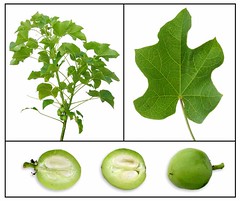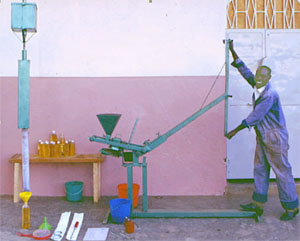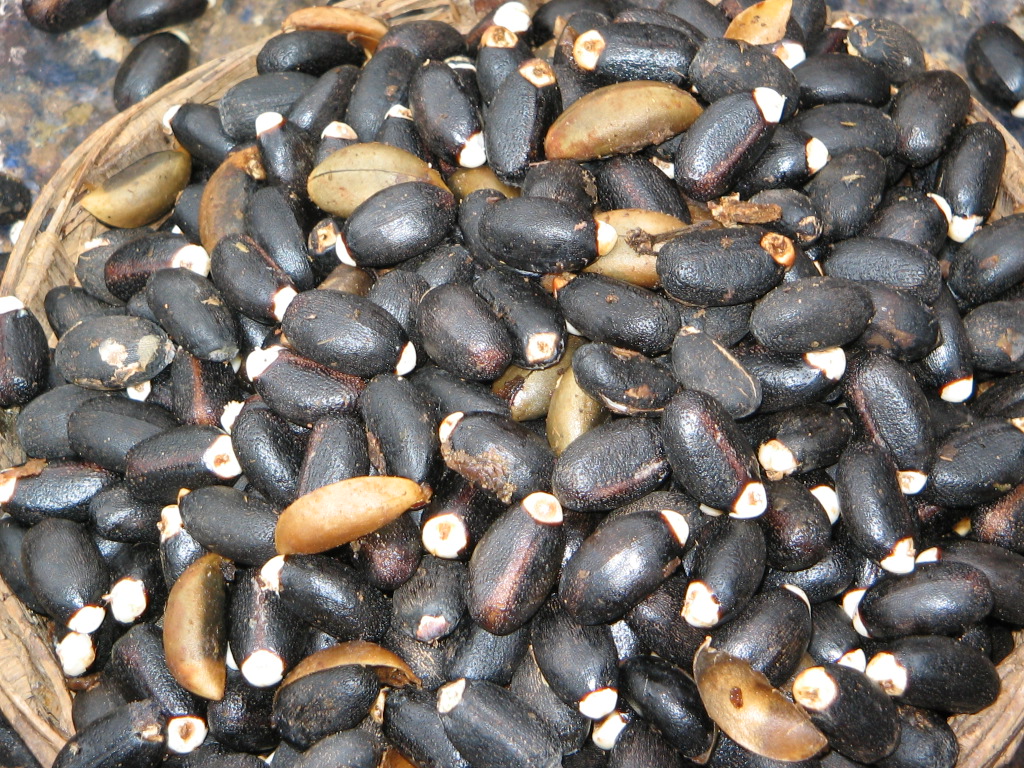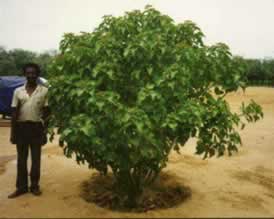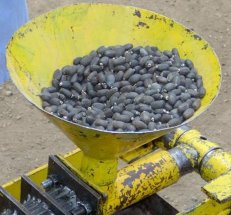My compilation on Jatropha, this is really exciting to see such a rapid development in India.
Jatropha the wonder plant produces seeds with an oil content of 37%. The oil can be combusted as fuel without being refined. It burns with clear smoke-free flame, tested successfully as fuel for simple diesel engine. The by-products are press cake a good organic fertilizer, oil contains also insecticide.
Jatropha curcus is a drought-resistant perennial, growing well in marginal/poor soil. It is easy to establish, grows relatively quickly and lives, producing seeds for 50 years.
It is found to be growing in many parts of the country, rugged in nature and can survive with minimum inputs and easy to propagate.
Medically it is used for diseases like cancer, piles, snakebite, paralysis, dropsy etc. this is amazing!
Jatropha grows wild in many areas of India and even thrives on infertile soil. A good crop can be obtained with little effort. Depending on soil quality and rainfall, oil can be extracted from the jatropha nuts after two to five years. The annual nut yield ranges from 0.5 to 12 tons. The kernels consist of oil to about 60 percent; this can be transformed into biodiesel fuel through esterification.
Family: Euphorbiaceae Synonyms: Curcas purgans Medic. Vernacular/common names: English- physic nut, purging nut; Hindi - Ratanjyot Jangli erandi; Malayalam - Katamanak; Tamil - Kattamanakku; Telugu - Pepalam; Kannada - Kadaharalu; Gujarathi - Jepal; Sanskrit - Kanana randa.
Distribution and habitat
It is still uncertain where the centre of origin is, but it is believed to be Mexico and Central America. It has been introduced to Africa and Asia and is now culti-vated world-wide. This highly drought-resistant spe-cies is adapted to arid and semi-arid conditions. The current distribution shows that introduction has been most successful in the drier regions of the tropics with annual rainfall of 300-1000 mm. It occurs mainly at lower altitudes (0-500 m) in areas with average an-nual temperatures well above 20°C but can grow at higher altitudes and tolerates slight frost. It grows on well-drained soils with good aeration and is well adapted to marginal soils with low nutrient content.
Botanical Features
It is a small tree or shrub with smooth gray bark, which exudes a whitish colored, watery, latex when cut. Normally, it grows between three and five meters in height, but can attain a height of up to eight or ten meters under favourable conditions.
Leaves
It has large green to pale-green leaves, alternate to sub-opposite, three-to five-lobed with a spiral phyllotaxis.
Flowers
The petiole length ranges between 6-23 mm. The inflorescence is formed in the leaf axil. Flowers are formed terminally, individually, with female flowers usually slightly larger and occurs in the hot seasons. In conditions where continuous growth occurs, an unbalance of pistillate or staminate flower production results in a higher number of female flowers.
Fruits
Fruits are produced in winter when the shrub is leafless, or it may produce several crops during the year if soil moisture is good and temperatures are sufficiently high. Each inflorescence yields a bunch of approximately 10 or more ovoid fruits. A three, bi-valved cocci is formed after the seeds mature and the fleshy exocarp dries.
Seeds
The seeds become mature when the capsule changes from green to yellow, after two to four months
Flowering and fruiting habit
The trees are deciduous, shedding the leaves in the dry season. Flowering occurs during the wet season and two flowering peaks are often seen. In permanently hu-mid regions, flowering occurs throughout the year. The seeds mature about three months after flowering. Early growth is fast and with good rainfall conditions nursery plants may bear fruits after the first rainy season, direct sown plants after the second rainy season. The flowers are pollinated by insects especially honey bees.
Ecological Requirements
Jatropha curcas grows almost anywhere , even on gravelly, sandy and saline soils. It can thrive on the poorest stony soil. It can grow even in the crevices of rocks. The leaves shed during the winter months form mulch around the base of the plant. The organic matter from shed leaves enhance earth-worm activity in the soil around the root-zone of the plants, which improves the fertility of the soil.
Regarding climate, Jatropha curcas is found in the tropics and subtropics and likes heat, although it does well even in lower temperatures and can withstand a light frost. Its water requirement is extremely low and it can stand long periods of drought by shedding most of its leaves to reduce transpiration loss. Jatropha is also suitable for preventing soil erosion and shifting of sand dunes.
Biophysical limits
Altitude: 0-500 m, Mean annual temperature: 20-28 deg. C, Mean annual rainfall: 300-1000 mm or more.
Soil type: Grows on well-drained soils with good aeration and is well adapted to marginal soils with low nutrient content. On heavy soils, root formation is reduced. Jatropha is a highly adaptable species, but its strength as a crop comes from its ability to grow on very poor and dry sites.
+++
Wild jatropha stirs hope of biodiesel bounty
Firms are contracting villagers to grow the hardy, oil-rich plant
Hari Ramachandran. Malegaon
Reuters: The glow from burning jatropha seed torches has often saved Maruti Chindu from treading on snakes, but now he carefully nurtures them for a use that he never imagined before — running cars and trucks.
On the hilly grasslands of Maharashtra, near the village of Malegaon, Chindu and his tribe of some 40 men and women busily plant jatropha saplings. The saplings are expected to bear seed in three to four years, one of dozens of new biodiesel projects being planned by private firms to feed the nation's galloping energy needs.
Once the trees start bearing seeds, they will continue the yields for the next 30 years without a break. "When electricity came to our village eight, 10 years ago, everybody just forgot about the jatropha trees," said Chindu. "We could not believe our ears when people offered to pay us to cultivate jatropha trees on our lands," he added.
In anticipation of the rapidly evolving biofuels market, dozens of private firms are contracting villagers to grow the hardy, oil-rich plant in their mostly barren plots of land. In the past, the tribes — who have suffered caste discrimination for years — would randomly pluck the fat, green seeds of the jatropha and set them on bamboo spikes to make torches. But now they treat the plant almost reverentially.
India plans to replace around five per cent of its current 40 million tonnes of annual diesel consumption with jatropha biodiesel within about five years. Nearly half a dozen states have set aside a total of 1.72 million hectares of land for jatropha cultivation and small quantities of the oil were already being sold to industry. However, it might take around four years until jatropha fuel is sold at the pump, said a senior government official.
+++
Biodiesel in India
Jatropha is a genus of approximately 175 succulents, shrubs and trees (some are deciduous, like Jatropha curcas L.), from the family Euphorbiaceae. Plants from the genus natively occur in Africa, North America, and the Caribbean.
Originating in the Caribbean, the jatropha was spread as a valuable hedge plant to Africa and Asia by Portuguese traders. Currently the tree is widely used for getting Biodiesel in India, and is being promoted as a very easy to grow biofuel crop in hundreds of projects throughout India and the third world. The rail line between Mumbai and Delhi is planted with Jatropha and the train itself runs on 15-20% biodiesel. The mature small trees bear male and female inflorescence, and do not grow very tall.
Here are some selected species, with use:
- Jatropha aconitifolia, leaves of this tree were boiled and eaten by the Maya.
- Jatropha cuneata, stems are used for basket making in Mexico.
- Jatropha curcas , also called physic nut, is used to produce the non-edible Jatropha oil, for making candles and soap, and as an ingredient in the production of biodiesel. The trees produce 1600 liters of oil per hectare. The cakes remaining after the oil is pressed out can be used for cooking, for fertilizing, and sometimes even as animal fodder, while the seed husks can be used to fuel generators. Large plantings and nurseries of this tree have been undertaken in India by women's Self Help Groups, using a system of microcredit to ease poverty among the nation's semi-literate population of women. Extracts from this species have also been shown to have anti-tumor activity. The seeds can be used as a remedy for constipation, wounds can be dressed with the sap, and the leaves can be boiled to obtain a malaria and fever remedy.
- Jatropha gossypifolia, also called bellyache bush, its fruits and foliage are toxic to humans and animals. It is a major weed in Australia.
- Jatropha podagrica, was used to tan leather and produce a red dye in Mexico and the Southwestern United States. May also be used as a house plant.
+++
Jatropha has been selected by the Indian Government as one of the plants to provide alternative fuel for the coming years. The government has identified 400,000 square kilometres (98 million acres) of land where jatropha can be grown, hoping it will replace 20% of diesel consumption by 2011. This has provided much needed employment to the rural poor of India and also a means to energy Independence to India.
The Indian Railways has started to use the oil (blended with diesel fuel in various ratios) from the Jatropha plant to power its diesel engines with great success. Currently the diesel locomotives that run from Thanjavur to Nagore section and Tiruchirapalli to Lalgudi, Dindigul and Karur sections run on a blend of Jatropha and diesel oil.
The President of India Dr. Abdul Kalam is a strong advocate of jatropha cultivation for production of bio-diesel. In his recent speech, the President said that out of the 60 million acres (240,000 km²) of waste land that is available in India over 30 million acres (120,000 km²) are suitable for Jatropha cultivation. Once this plant is grown the plant has a useful lifespan of several decades. During it life Jatropha requires very little water when compared to other cash crops.
Recently the State Bank of India provided a boost to the cultivation of Jatropha in India by signing a Memorandum of Understanding with D1 Mohan to give loans to the tune of 1.3 billion rupees to local farmers in India. Farmers will also be able to pay back the loan with the money that D1 Mohan pays for the Jatropha seeds.
+++
Chhattisgarh has decided to plant 160 million saplings of jatropha in all its 16 districts during 2006 with the aim of becoming a bio-fuel self-reliant state by 2015. Chhattisgarh plans to earn Rs.40 billion annually by selling seeds after 2010. The central government has provided Rs.135 million to Chhattisgarh this year for developing jatropha nursery facilities.
In May 2005, Chief Minister Raman Singh became the first head of a state government to use jatropha diesel for his official vehicle. Chhattisgarh plans to replace with jatropha fuel all state-owned vehicles using diesel and petrol by 2007.
+++
Maharashtra to offer 30,000 ha to pvt sector for jatropha cultivation
THE Maharashtra Government is planning to make available 30,000 hectares for jatropha cultivation to the private sector. It is learnt that Reliance Industries has already approached the State Government to get the land allocated for jatropha cultivation.
The Maharashtra Government's plan is to cultivate jatropha on 60,000 hectares in the State.
According to the sources in the Maharashtra Department of Non-conventional Energy, the State Government is likely bring out a Government Regulation by the year-end.
Cultivation of jatropha would be undertaken on wastelands, which are owned by the State Government. Poor and underprivileged sections of the society, women and self help groups would be given 50 per cent of the land for cultivation and management while rest of the land would be given to the private sector, the sources said.
The State Government not only wants to earn revenue through cultivation of jatropha but is also aiming to create rural employment and prevent soil erosion. It wants to create a model of energy self-sufficiency for the rural areas.
Earlier, Hindustan Petroleum Corporation Ltd had joined hands with Maharashtra State Farming Corporation Ltd (MSFCL), a State Government undertaking, for a jatropha seed based bio-diesel venture.
A pilot project has already been initiated, under which, jatropha would be cultivated in 500 acres in Nashik and Aurangabad.
According to the latest report on jatropha cultivation and processing, prepared by the State Agriculture Commissioner, Maharashtra plans to give a minimum of 10 hectares and a maximum of 25 hectares to NGOs involved in jatropha cultivation.
Individuals would get two hectares of land for 30 years. They would have to cultivate 1,600 jatropha trees per hectare of land. Out of the total revenue generated, 20 per cent would have to be given to the State Government.
+++
Oil from a Wasteland - The Jatropha Project in India
In a simple process plant oil is converted into bio diesel fuel. Crossing India a Mercedes-Benz C-Class tested the fuel on the road.
From Jatropha Oil to Biodiesel
Parallel to the search for the most effective way to cultivate the jatropha plant, the project partners are pursuing another important goal: the development of a simple and economical process for converting the plant oil extracted from the oilseed into high-quality biodiesel fuel. For this purpose, the scientists at CSMCRI have set up three small pilot plants in Bhavnagar that have a combined production capacity of 100 liters of biodiesel per day.
In these chemical mini-factories, the jatropha oil is subjected to a process called transesterification. Plant oils - those derived from jatropha as well as the oilseed rape and soya beans from which biodiesel is produced in Europe and the U.S. - consist mainly of triglycerides, the fatty acid esters of glycerin. They are extremely viscous and tend to resinification - qualities that are not desirable inside a fuel tank.
Transesterification, in which the glycerin is replaced by methanol, makes it possible to use the processed plant oil as fuels. However, that's only the first step in the transformation of plant oil into biodiesel. After transesterification, the resulting raw product is centrifuged and washed with water to cleanse it of impurities, such as glycerin and excess methanol. Only at the end of this process is the biodiesel of usable quality.
The CSMCRI team was not willing to wait until after the first harvest in order to start the search for the right process for refining jatropha oil, so it bought eight tons of jatropha nuts that farmers had gathered from wild plants in various parts of India. By spring 2004, the team had extracted a total of 1,300 liters of high-quality biodiesel from this raw material using a variety of processes. The biodiesel was passed to DaimlerChrysler India, which used it to fuel an eye-catching round trip through the country. A Mercedes-Benz C 220 CDI specially modified to use jatropha biodiesel toured the country between April and May 2004, covering around 5,900 kilometers and visiting 11 major cities on a route extending from Pune to Bangalore, Hyderabad, Mumbai and Delhi.
Powered by diesel fuel made of jatropha seeds this Mercedes-Benz C 220 CDI covered a distance of 5900 kilometers across India.
The results of the experiment have been very satisfactory for two reasons. Firstly, it has revealed that jatropha-based biofuel can be used without any problems in modern CDI engines adapted for biodiesel. What's more, this fuel produces only half of the unburned hydrocarbon emissions and one-third of the particulate emissions produced by diesel fuel derived from crude petroleum.
Secondly, the team from DaimlerChrysler India received a tremendous amount of public interest. According to George Francis from the project team headed by Klaus Becker in Hohenheim, two more Indian states are now in the process of setting up and financing jatropha cultivation in wasteland areas.
The fuel specialists at DaimlerChrysler Research, under the leadership of Rudolf Maly, have now taken an in-depth look at the quality of biodiesel made from jatropha. "This fuel has not yet reached optimal quality, but it already fulfills the EU norm for biodiesel quality," says Maly. "That's a remarkable achievement, in view of the simple production processes involved." Maly's team subjected the emissions associated with jatropha biodiesel to tough laboratory tests that confirmed their Indian colleagues' observations of the advantages of this fuel. In addition, this renewable fuel's high cetane values, very low sulfur content and high oxygen content give it excellent combustion properties.
"What's more, the CO2 balance of fuels derived from renewable energy sources is much better than that of fuels based on crude oil," Maly adds. After all, the combustion of biodiesel releases only the amount of CO2 that the plant removed from the atmosphere when it was growing. Only the amount of energy used for the cultivation, harvesting and transport of the plants plus the energy needed to produce biodiesel affects the CO2 balance. And in principle, it is possible to significantly reduce that energy figure.
Source: DaimlerChrysler, Reuters, Wiki, DNA, Jatropha World, Jatropha Bio Diesel
